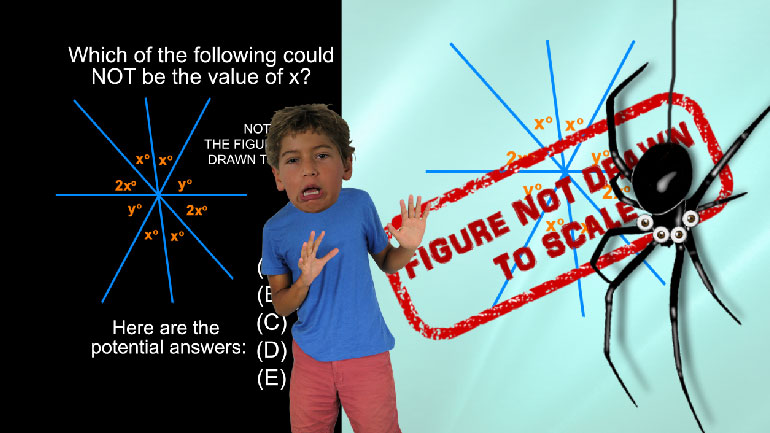ShmoopTube
Where Monty Python meets your 10th grade teacher.
Search Thousands of Shmoop Videos
Factoring Trinomials of the Type ax^2 + bx +c 2329 Views
Share It!
Description:
There are a variety of methods for factoring trinomials, Complete the square! Use the quadratic formula! Or be a genius and do it in your brain!
Transcript
- 00:04
Factoring Trinomials of Type ax2 +bx +c, a la Shmoop
- 00:10
Farmer Jen Etticks produces donut-shaped watermelons. [Farmer carrying a watermelon]
- 00:14
Like Godzilla, they’re huge in Japan.
- 00:17
There’s just one problem: tossing the spoiled watermelons into the ocean has had some… [Farmer throws watermelon into the ocean]
- 00:22
undesirable effects.
Full Transcript
- 00:24
The guy in accounting says that the amount of spoilage, or “s”…
- 00:28
…for producing w number of watermelons per day can be approximated by the formula: [accounting guy discussing formula]
- 00:34
s equals 6w squared plus 13w plus 2.
- 00:40
What daily production level will give Jen zero spoilage?
- 00:45
This looks like a trinomial equation of the type ax squared plus bx plus c; [man points to trinomial equation]
- 00:50
To find the answer, we’re going to need to factor out the a and the c in the equation.
- 00:55
We’ll do this by using a table. [Dinosaur jumps on a table]
- 00:58
Our table has four columns.
- 01:00
The first involves our “a-term”, 6w squared.
- 01:05
There are two possible ways to factor 6w squared: 3w and 2w, and 6w and w.
- 01:13
The second column factors our “c-term”, 2.
- 01:17
The only possible factors are 2 and 1.
- 01:20
The third and fourth columns use the previous two columns to decipher possible “b-terms”.
- 01:26
Combinations of the a-term and c-term factors are combined in the “possible binomial factors” [arrow pointing to binomial factors column]
- 01:32
column.
- 01:33
If we take a look at the first row of the first two columns, our possible binomial factors
- 01:37
come out to:
- 01:38
(3w + 2) times (2w + 1), and (3w+1) times (2w+2).
- 01:46
For the second row, we get (6w +2) times (w+1), and (6w+1) times (2+2).
- 01:55
Then, the sum of the inner and outer products are used to calculate what the b-term for
- 02:00
that product would be.
- 02:01
So for (3w +2) times (2w + 1), we take the outer product first, which is 3w times 1, [table of factoring trinomials]
- 02:10
and add it to the inner products: 2w times 2.
- 02:14
3w times 1 is 3w, and 2w times 2 is 4w.
- 02:19
So the sum is 7w.
- 02:21
Not the right b-term...so we keep trying. [man points to b-term]
- 02:24
After doing all the calculations, we can see that the factors (6w + 2) and (w + 2) give
- 02:30
us our correct b-term, 13w, hiding out like a bunny at a fox convention. [fox hiding among bunnies]
- 02:35
Our work can be checked using FOIL, multiplying out the first terms, outer terms, inner terms,
- 02:42
and last terms,.
- 02:44
We add them together…and check to see that they equal our original trinomial. [man looking at the completed formula]
- 02:50
We passed the checkpoint, which means when spoilage equals zero, one of our factors must
- 02:55
also equal zero.
- 02:58
When we set each factor to zero and solve for w…
- 03:00
…we see there is zero spoilage when our daily watermelon production equals negative
- 03:05
one sixth and negative 2. [doughnut watermelons appear]
- 03:07
Uh-oh.
- 03:08
Since it’s impossible to have negative production…
- 03:10
…looks like Farmer Jen has no choice but to introduce spoiled watermelons into the [farmer Jen throwing a watermelon into the ocean]
- 03:16
food supply.
- 03:17
Good luck, everyone.
Up Next
Related Videos
CAHSEE Math: Algebra I Drill 6, Problem 2. Simplify the polynomial.
GED Math 3.1 Expression and Equations. What is the maximum output impedance that the amplifiers can have?
Math Elementary Algebra: Drill 1, Problem 4. Solve for y using substitution.




